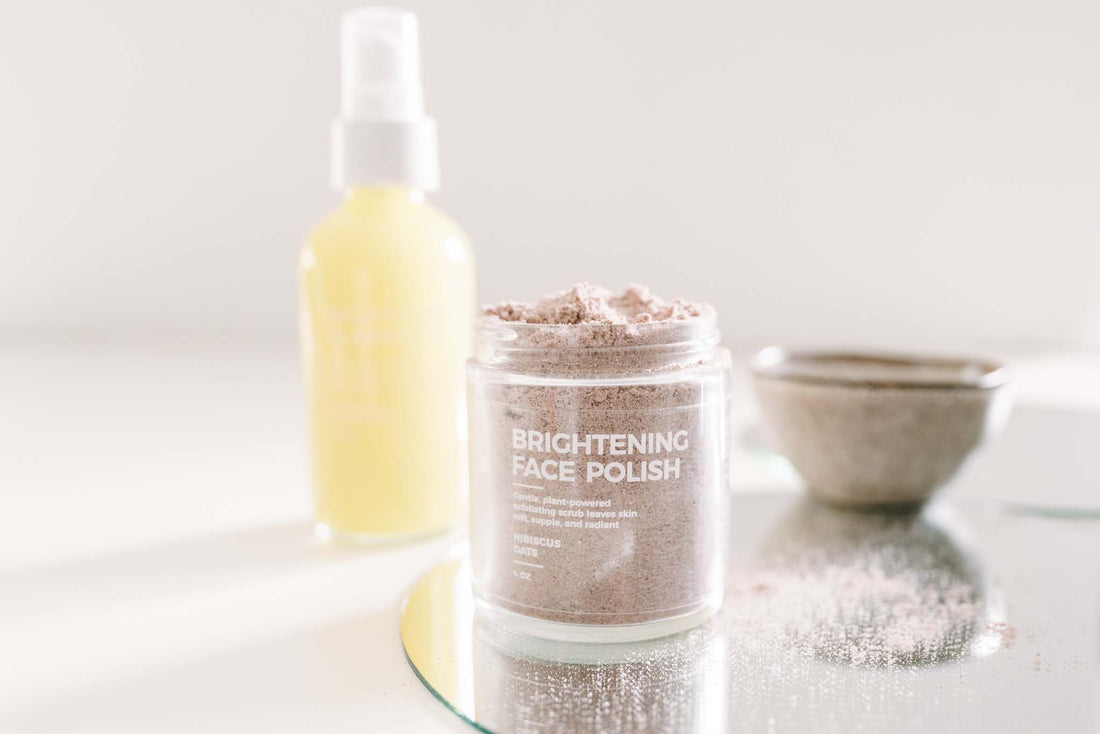
How to Exfoliate — Everything You Need to Know
Should I be exfoliating? How often should I exfoliate? What should I exfoliate with? Is exfoliating okay for my sensitive skin?
These are all fantastic questions that we get asked regularly. Quite often, in fact, people will dive into a new product or in this case, a new exfoliant, before having all of the answers. It’s important, however, to know how to exfoliate before you touch that precious face of yours!
Let’s first start with what exfoliating IS. Exfoliation is essentially the process of removing dead skin cells from the surface of the skin. It is super beneficial for cell turnover (the process in which your skin produces new skin cells and sheds the old), keeping your complexion bright and healthy.
Not exfoliating can leave your skin dull-looking, dry, and rough to the touch, as well as lead to clogged pores and breakouts. Plus, as we age, cell-regeneration slows down, all the more reason to give your skin the boost it needs by exfoliating. Removing dead skin cells will also allow for your moisturizer and any treatments applied to your skin to properly penetrate.
How Often Should You Exfoliate?
The quick answer is…it depends. The frequency with which you exfoliate should really be determined by your skin type. In fact, you should approach your entire skin care routine with this same mentality. Your skin is entirely unique and should be treated as such! What works for someone else, may not work for you and vice versa. One rule of thumb though is to exfoliate no more than 3 times per week. Your skin needs time to heal and regenerate and it cannot do that if you’re continually removing its layers. You run the risk of irritating your skin, causing redness, inflammation, and even acne. If you have sensitive skin, we suggest sticking with exfoliating no more than once per week.
If you’re new to exfoliating, start with once per week. You can always build up to 2 or even 3 times per week if you’re finding that your skin is doing well with it and can handle the increased exfoliation.
Exfoliation 101
There are two main types of exfoliation, chemical and mechanical.
Chemical Exfoliation
Chemical exfoliation is the process of using chemicals, such as acids (e.g. alpha hydroxy acid, beta hydroxy acid, glycolic acid) or enzymes (e.g. fruit enzymes), to exfoliate. This is a great choice for anyone whose skin does not fair well with scrubbing. Chemical exfoliation can also sometimes work well for those with oily skin and/or acne. Chemical exfoliants work by loosening the bonds that hold dead skin cells together. There are various types of acids and enzymes that all function differently, so it’s important to do your homework before trying something new to ensure you’re choosing the right product for your skin type and needs. Chemical exfoliants can also leave your skin sensitive to the sun so be careful and wear sunscreen!
Enzyme-based exfoliants can be finicky and must be kept under strict conditions and maintain their pH to ensure they remain stable. When stored under the wrong conditions (such as in direct sunlight or a super warm room) they can be rendered useless.
Mechanical Exfoliation
Mechanical exfoliation is the process of loosening or removing dead skin cells from the surface of the skin through some form of friction/abrasion. You can do this with tools or ingredients in skin care. Some tools may include a brush or specialty exfoliating pad. Common exfoliating ingredients include sugar, oats, and rice, however, there are many more out there.
Mechanical exfoliation is a quick and simple way to remove the outermost layer of dead skin cells, however, not all mechanical exfoliants are created equal. Avoid any exfoliants that are overly sharp or harsh which can cause micro-tears in the skin and lead to irritation. You should also be sure to avoid applying too much pressure or scrubbing too harshly, light pressure is enough. If you have acne or active breakouts, steer clear of mechanical exfoliants until you’ve healed, or avoid the areas of your skin with active breakouts. Scrubbing over acne can cause the breakouts to burst and spread bacteria across the skin, leading to further breakouts.
How to Know if a Product will Work Well on your Skin
Make sure you do your research before you try a new exfoliant to ensure it suits your skin type and you aren’t allergic to its ingredients. If all checks out and you purchase a new product to try, you should still patch-test before fully using the product to ensure you don’t have an adverse reaction to it. These steps will give you a pretty good idea as to whether or not a product is going to be safe for you before you apply it all over your face. Again, make sure you start slow when trying a new exfoliant to avoid shocking and irritating your skin.
What Do You Do if You’ve Over-exfoliated
Over-exfoliating your skin may cause redness, inflammation, dryness or oiliness. If you think you’ve over-exfoliated with your chemical or mechanical exfoliant (or both), give your skin a break. Apply a really good moisturizer to protect your damaged skin. Wait a week or two, then reassess how your skin looks and feels. Be sure to ease back into your exfoliation routine and be gentle with your skin! Less is more.
Check out how Carolynne Cantila of Cary Day Yoga exfoliates with Brown & Coconut using our Hibiscus Cleansing Grains.
Photograph Courtesy of Michael Benjamin Blank. Instagram: @michaelblankphotography
